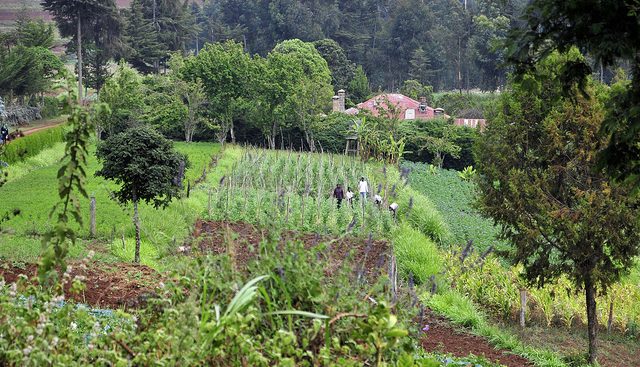Latest
Food, Farms, and Forests: The Chaos of Fear and High Expectations
By Julie Lerner, Founder and CEO, PanXchange
The Cornerstone: Journal of Sustainable Finance and Banking, Volume III Issue 1, January 2016, pp. 33-35
We have grave concerns in today’s world agricultural commodity markets, and I’m not speaking of trade houses’ shrinking profit margins. There’s fear of a global food shortage and fear that we cannot succeed in the war on poverty. In the West we have constant reminders of how the lack of traceability yields food security threats and in Asia of how it leads to deforestation. And where there is fear, there are hasty and chaotic attempts to address the problems. We are all eager to create double or triple bottom line success stories, but as shrewd business people, we need to slow it down and take a more pragmatic approach. The complexities involved in establishing secure and sustainable food supplies require patience and granular focus, with success measured in small increments. Once we get out of the mad scramble to solve the problems, we’ll begin to see the obstacles that can and must be cleared before we can reach impact at scale.
In Africa, agriculture employs half the continent’s population, but its contribution to GDP hovers at an average of 15%. Productivity is abysmal despite vast amounts of arable land. Undernourishment persists across the continent. This is a frustrating scenario given the numerous studies that illustrate how improving the livelihoods of smallholder farmers strengthens the agrarian economy, thus reducing poverty and food security concerns.
With this backdrop, one can see the interest and urgency in creating a national or regional exchange as a cure-all for our commodity fears. Its success could bring farmers higher incomes and the transparency could help improve regional trade flows, decreasing the reliance on ocean imported commodities. In the brightest of outcomes, commodity derivative contracts will be formed and outside investors will begin to pour money into the market. Everybody wins. But our direct experience with PanXchange has illustrated that the race to establish the pre-eminent commodity exchange solution is rife with presently intractable issues.
The Challenges of Creating Order
In August 2015, PanXchange launched PXAfrica, its cloud-based software to facilitate the negotiation and transfer of agricultural commodities from seller to buyer in East Africa. Arguably, this is the weakest link in any supply chain and our goal is to bring efficiencies and transparency to all market participants. We are neither government-sponsored nor donor-funded. As such, we focus solely on creating efficiency and profit opportunities for producers, traders, warehouses and processors.
PXAfrica has met with tremendous success, but it is not without its challenges. For instance, there is not enough reliable and economically viable warehousing space for farmers and importers. This forces the majority of stakeholders to take the spot price offered in the market. Also, some buyers insist on receiving a sample even though doing so does not guarantee that the grains weren’t sent from a different farm or even different country. Once we overcome this hurdle, there will still be a risk of blending en route to the processors. This risk forces the sellers to send an escort on each delivery truck to ensure the product isn’t tampered with en route to the buyer. Moreover, rural communities do not have the equipment to properly ascertain the quality of their crops. This is another vulnerability point that weakens the negotiating power of the smaller farmers, as they must trust the buyer to confirm that, for example, the moisture content of the maize is low enough to earn the EAC Maize 1 grading and subsequent premium price.
These examples should give pause. Per my last article for the JSFB, several entities are attempting to address all these issues in one fell swoop, creating aggregation and storage centers as well as derivative contracts that attract outside investors. This is all fantastic in theory, but thus far, these efforts have proven too costly for the farmers, with unmanageable overhead for the exchange venture.
In East Africa, the task of addressing the harmonization of cross-border standards is achieving real results that could lead to greater economic strength and improved regional food security. Standardized commodity crops could reduce dependence on world market imports and also bring liquidity to markets and efficiency in processing.
In East Africa, the task of addressing the harmonization of cross-border standards is achieving real results that could lead to greater economic strength and improved regional food security. Standardized commodity crops could reduce dependence on world market imports and also bring liquidity to markets and efficiency in processing.
PXAfrica uses the East Africa Community (EAC) standards as a foundation for the commodities that our members negotiate. While we would like to require users to trade only these grades for the purpose of liquidity, we know we cannot. One small but specific example of this is Ugandan maize. Maize grown in the western region is shaped differently than maize grown in Kenya which causes processing problems for Kenyan millers. As such, PXA lists “Uganda high quality maize” in addition to EAC Maize 1, 2 and 3. This provision keeps the Ugandan maize in the supply chain as millers can now submit bids with an appropriate discount to adjust for the processing cost.
The majority of the EAC working groups are policymakers and agronomists who are considering enforcing these quality specifications as mandatory. However, beyond trade policy and climate and soil issues, we have yet to consider the market factors. There is no “one-size fits all” solution, and producers and processors could provide many more reasons to resist mandatory quality standards beyond the example explained above.
In terms of traceability, when fires in Indonesia were burning out of control last year, several companies acknowledged the deforestation problem by signing a declaration to save between 4.5bn and 8.8bn tons of carbon emissions per year by 2030. Some companies such as ADM and Wilmar went a step further and implemented a zero tolerance policy toward palm oil that originates from newly destroyed rain forests or carbon-rich peat. The companies that signed the declaration, such as Cargill, Kellogg, Marks and Spencer’s and Nestlé, have the kind of influence and resources to effect real change. Few could doubt the sincerity of the commitment to address the problem, but again we are faced with the question of how. Even Cargill’s CEO, David MacLennan, notes the challenges of the commitment without local government coordination. More specifically, how can we confirm where each batch of palm oil originates?
The economics of food traceability are a global challenge. Is there enough palm oil from acceptable plantations that will supply an oil processor with 100% of their needs? If not, the “pure” oil will be blended with non-certified oils, thus rendering a zero-tolerance policy useless.
Guaranteeing the traceability of a crop from farm to table is usually cost-prohibitive. Food that is fit for direct human consumption is an industrial process that benefits from economies of scale. Thus, until more crop inputs are certifiable, you need to either run the mill at less than capacity to protect the traceability or blend it to protect your operating margin.
I am not an economist nor an agronomist, but as a former commodity trader, I believe this will be the toughest issue to address of those mentioned herein due to the lack of economically viable solutions.
An Orderly Approach Needed
We’ve spent decades trying to solve the problem with broad strokes and mountains of donor dollars, yet we’re all still here with the same set of problems. The rise in socially responsible investing is a positive development, but to effect real change, we need to slow it down and take an orderly approach to these challenges, breaking them down step-by-step with practical and economically viable actions. What incentives could we create for palm producers in Southeast Asia to reduce deforestation? Who will invest in aggregation and storage facilities for smallholder farmers, yielding greater leverage in their post-harvest pricing? Who can contribute the experienced, on-the-ground manpower to explore the best crop inputs for the widest region without bias?
There’s chaos in fear and it pushes us to make rash decisions hoping for a quick fix for complex issues. We can address these challenges if we take a systematic and patient approach that also considers the market solution. It may not lead to the big headlines of success next year, but we all know that lasting change is evolutionary.


